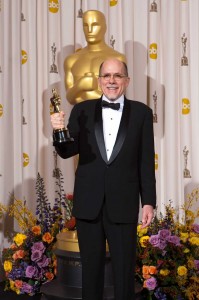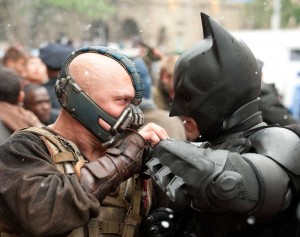
The Dark Knight Rises, the latest film in Christopher Nolan‘s Batman trilogy, is the fourth film that sound designer Richard King has done with the director. King, who has been designing sound for a long time, went into the film without a grand vision because he believes “having preconceptions are going to close you off to other avenues that might be more productive and more interesting.”
Sound design, especially for a film with the scope of The Dark Knight Rises, is a long process. A script may impress King, but it does not conjure up sound ideas for him. Although he can create some sounds for picture editor Lee Smith to add to the cut based on the description of certain pieces of machinery, vehicles or weapons, the audio work really begins when he gets the edited picture. “That is what inspires me, the images,” said King. “That is where I start my best work.”
The biggest challenge on the film was coming up with a concept for Bane’s voice, the villain whose presence filled the screen and whose voice needed to match that immense presence. Essentially what they had to work with was a man in a mask whose face could barely be seen. “The acting is all in the eyes, the body language and the voice,” explained King. “The sound that we used was almost all production recording. There was a microphone inside the mask, as well as a boom mic, and it sounded like a dude in a mask! It did not sound particularly impressive. We had to try a lot of things to make the voice as impressive as the character.”

The sound team added mechanical elements, but that was too distracting, so they ended up striping a lot of sounds away so that the voice stood out, allowing Tom Hardy‘s performance to be key. “Gary Rizzo, the dialog mixer, did a lot of treatments that added a subtle mechanical element and we played with the voice spatially, having Bane’s voice come out of more speakers in the theater. So when he’s on screen, his presence is predominant. He’s big and overpowering.” Once they settled upon the core concept, the team was able to adjust the voice within the parameters of the design to fit each particular scene that the character appeared in.
It was a long process of trial and error to figure out how to deal with the voice and other important sound choices like “The Bat,” the vehicle Batman flies around. Also, because Nolan preferred production sound, dialog editor Hugo Wang had extensive dialog work, sometimes swapping syllables or even letters to make the tracks work without looping.
The temp mix was the beginning of the final. It was automated and virtual, so the work served as a template for the final mix that took seven-eight weeks. The team screened the film weekly during the mix. With each of the seven passes, different problems were addressed. It kept them from getting bogged down as the sound evolved and was upgraded from one mix to the other.
The overall challenge of the film was to make the movie “feel bigger and more epic.” King explained, “To me, this was the epic of the three, if you could categorize it. It had a David Lean quality to it. It had so many emotional beats and characters plus set-piece action scenes. We really worked hard to make it feel as epic and as huge as possible. Part of that was inspired by the Bane character, because he is such a gargantuan figure. We had to amp things up, not necessarily make them louder, but make them feel bigger.”





